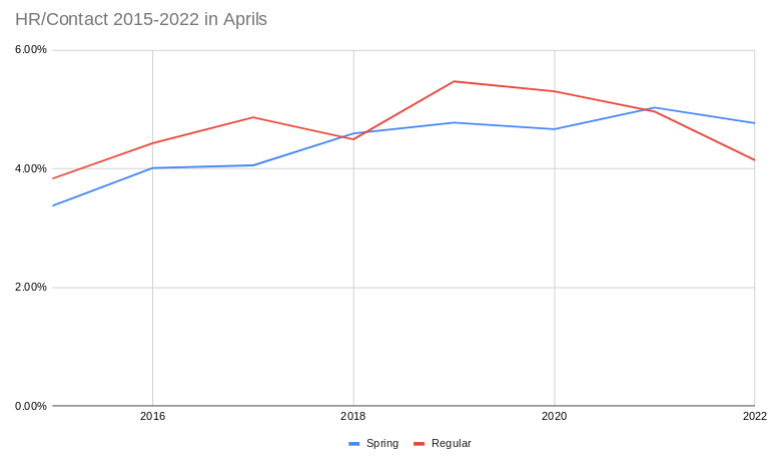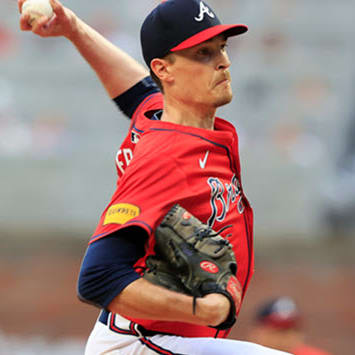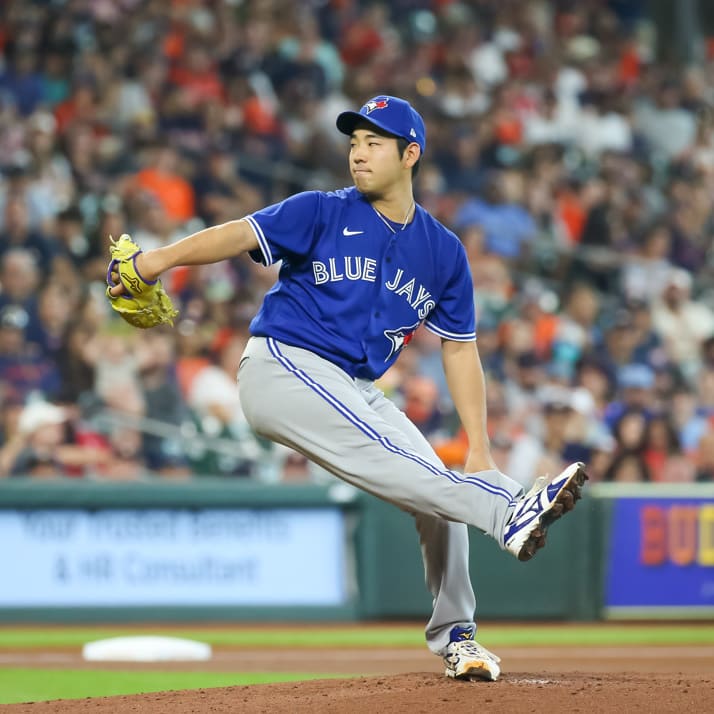This article is part of our Collette Calls series.
One year and one week ago, my weekly installment of this column was about how I was worried that 2021 would be a down year for power. That particular piece was building off something Rob Arthur and Ben Lindbergh wrote at The Ringer about the new baseball, and from that piece written roughly 10 days into the season, I cited the league was projected to hit 6,200 homers based on the data at hand. The league ended up falling well short of even that total, finishing with 5,944 homers, which was a precipitous fall from the 2019 Happy Fun Ball total of 6,776.
This year is looking like another fall as well. I hinted at it in last week's installment, but the early numbers are pointing in a very similar direction, and let me explain why.
Yes, everyone's training schedule has been disrupted by the lockout and rapid rush to Florida and Arizona to jump into the accelerated spring training. It did not seem to impact offense in those camps though as the teams had a higher collective batting average this spring than the previous one by nine points. Early on this regular season, we have seen a struggle as the league was hitting a mere .222 the first three days of the season until they played catchup against the back-end of rotations the past few days and have pushed that average up to .232, which is exactly where it was for April of 2021. The league strikeout rate has
One year and one week ago, my weekly installment of this column was about how I was worried that 2021 would be a down year for power. That particular piece was building off something Rob Arthur and Ben Lindbergh wrote at The Ringer about the new baseball, and from that piece written roughly 10 days into the season, I cited the league was projected to hit 6,200 homers based on the data at hand. The league ended up falling well short of even that total, finishing with 5,944 homers, which was a precipitous fall from the 2019 Happy Fun Ball total of 6,776.
This year is looking like another fall as well. I hinted at it in last week's installment, but the early numbers are pointing in a very similar direction, and let me explain why.
Yes, everyone's training schedule has been disrupted by the lockout and rapid rush to Florida and Arizona to jump into the accelerated spring training. It did not seem to impact offense in those camps though as the teams had a higher collective batting average this spring than the previous one by nine points. Early on this regular season, we have seen a struggle as the league was hitting a mere .222 the first three days of the season until they played catchup against the back-end of rotations the past few days and have pushed that average up to .232, which is exactly where it was for April of 2021. The league strikeout rate has even improved early on as the league is striking out in 23% of plate appearances this season compared to 24.4% in the first month of last season.
Yet, homers are not joining the party.
Citing the same HR/Contact metric as my previous work, this is where the data stands as play begins on April 13th:

It is worth noting the spring training rate has continued on an upward trend whereas the regular season rate has been on a downward trend the past few seasons as regular season factors have continued to come into play. In the past few seasons we have gone from humidors in select parks to all 30 parks as well as substance enforcement on pitchers whereas only one of those factors has been in play in spring training, and it was only the most recent one. Another factor to consider is the heavy use of pitching by committee thus far with teams taking advantage of the deeper bullpens while allowing some of their younger starters more time to build up stamina lost in the shortened spring.
In that same time, the early home run per plate appearance rate has been a strong indicator of how the rest of the season has played out. Last year, we did not see too much of a drop off from the rest of the season over the first two weeks, but the early rate here in 2022 should make you sit up and take notice:
Season | Early HR/PA | Final HR/PA |
|---|---|---|
2016 | 36.2 | 32.9 |
2017 | 32.5 | 30.4 |
2018 | 36.1 | 33.1 |
2019 | 29.3 | 27.5 |
2020 | 30.2 | 28.9 |
2021 | 31.6 | 30.6 |
2022 | 36.9 | ?? |
Looking back over the entirety of the Statcast Era (2008-2022), the early season HR/PA rate has not exceeded the final rate in a season since 2013. In short, what happens early in the season portends how the rest of the season tends to play out. If this holds true, 2022 is going to be unlike any season we have seen in some time:

Max Freeze of FreezeStats pulled some data on Twitter showing things just over the past two seasons:
🚨Is something up with the ball…again?🚨
2021 through 1st 5 days
242 BRLs
119 HR
49.2% HR/BRL%
105.2 MPH
26.1° LA
382 FT2022 through 1st 5 games
264 BRLs
108 HR
40.9% HR/BRL%🚨
105.2 MPH
25.9° LA
378 FTSmall sample but maybe someone smarter than me can dig into the data.
— Max Freeze (@FreezeStats) April 12, 2022
I simplified the inputs a bit, looking at just the average exit velocity and distance on both barrels as well as barrels+solid contacts from the BaseballSavant search tools and found this:
So far, barrels aren't traveling as far as they were this time last year pic.twitter.com/0qT37r6ejd
— Jason Collette (@jasoncollette) April 13, 2022
Thus far, guys are hitting the ball just as hard, but it is not traveling as far over the same date range as last April.
How can you apply this to your fantasy roster? Pitchers with high flyball rates may not be as risky if the ball is not going to be as lively as it has been in recent years. 2021 qualified pitchers who had a flyball rate of at least 35% and a strikeout rate of at least 20% include:
Name | FB% | HR/FB | K% |
48.3% | 11.7% | 34.1% | |
40.5% | 13.5% | 33.5% | |
44.2% | 15.9% | 32.1% | |
44.3% | 11.3% | 31.9% | |
40.5% | 13.5% | 29.8% | |
36.5% | 11.3% | 29.3% | |
45.3% | 14.6% | 29.2% | |
42.3% | 13.8% | 27.9% | |
36.6% | 14.1% | 27.7% | |
35.2% | 11.4% | 26.6% | |
41.2% | 9.4% | 26.2% | |
35.5% | 10.1% | 26.0% | |
35.8% | 13.8% | 25.7% | |
34.7% | 8.2% | 25.5% | |
36.4% | 11.0% | 22.5% |
A condition like this could also play into the hands of Minnesota if they want to look at Emilio Pagan as a full-time closer with his extreme flyball tilt (55%) and home run problems (1.7 HR/9 rate) over the course of his career. The recent news of Jorge Alcala hitting the IL with elbow inflammation removes one of the potential options Rocco Baldelli had in the bullpen.
I'll revisit this data at month's end to see how this plays out, but the early warning signs are there, allowing you to stay a step ahead of your competition.










